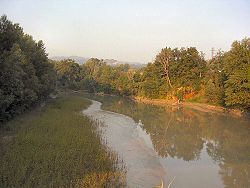Reno (river)
| Reno | |
|---|---|
 The river nearSasso Marconi,at the beginning of its course in the Pianura Padana | |
 Location of the Reno River in Italy | |
| Etymology | Celtic *Rēnos,"raging flow" |
| Native name | Raggn, Ränn(Emilian) |
| Location | |
| Country | Italy |
| Physical characteristics | |
| Source | |
| • location | TuscanApennines,Italy |
| Mouth | |
• location | Adriatic Sea |
| Length | 211.8 km (131.6 mi) |
| Basin size | 5,040 km2(1,950 sq mi) |
| Discharge | |
| • average | 95 m3/s (3,400 cu ft/s) |
TheReno([ˈrɛːno]) is a river ofEmilia-Romagna,northernItaly.It is the tenth longest river in Italy (the sixth longest of those that flow directly into the sea) and the most important of the region apart from thePo.
It has adrainage basinof about 5,000 square kilometres (1,900 sq mi).[1]The annual average discharge at the mouth is about 95 cubic metres per second (3,400 cu ft/s); at the point where the river starts to flow into thePianura Padana(Po River Plain), it amounts to about 25 cubic metres per second (880 cu ft/s).
The highest values registered at the mouth have approached 2,300 cubic metres per second (81,000 cu ft/s), but the typical value when the river is in flood is around 1,000 cubic metres per second (35,000 cu ft/s). The minimal discharge reported is 0.6 cubic metres per second (21 cu ft/s).
The river rises in the Le Lari massif of theprovince of Pistoia(Tuscany) at about 745 metres (2,444 ft) above sea level, from two streams that join near Le Piastre, in thecomuneofPistoia.Its upper course marks the border between Tuscany and Emilia-Romagna and it flows in a wooded area crossed by the Bologna-Porretta-Pistoia railway line (inaugurated in 1864 and one of the most outstanding for the time for its engineering work). The upper course is characterized by several artificial reservoirs whose dams are used forhydro-electricenergy production. The power produced in the basin of the Reno basin is second, forApenninerivers, only to that of theNera-VelinoinUmbria.
It passes west ofBologna,atCasalecchio di Reno. In its lower course the Reno receives the water of numerous streams, some of which are seasonal. The most important include theLimentra orientale,Silla,Setta,Samoggia,Idice,Sillaro,SanternoandSenio.
The Reno was a tributary of the Po until the middle of the 18th century when the course was diverted to lessen the risk of devastating floods. It now joins theAdriatic SeanearCasalborsetti,south-east of theValli di Comacchio.
The name of the river has the same etymology as the name of theRhine,as both derive from the same Celtic hydronym Rēnos,the Reno basin being situated withinGallia Cisalpina,in what was the territory of theBoiibefore theRoman conquestof 220 BC. InItalianboth rivers are calledReno,and inLatinboth were calledRhenus. In 43 BC the pact establishing theSecond triumviratewas signed on an islet of the river nearBononia(Bologna). The river is mentioned byDante Alighieriin Canto XVIII of hisInfernowhere he defines theBolognesias those "living between theSavenaand the Reno ".

Footnotes[edit]
- ^Reno Basin Authority
External links[edit]
- Historical and geographical info(in Italian)
